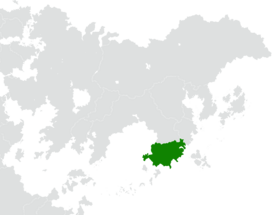Anachak Kang
This article is incomplete because it is pending further input from participants, or it is a work-in-progress by one author. Please comment on this article's talk page to share your input, comments and questions. Note: To contribute to this article, you may need to seek help from the author(s) of this page. |
Anachak Kang Hom Khao ອານາຈັກກາງຮົ່ມຂາວ (Kra) | |
|---|---|
| Motto: ສະບາສະມາ ສັງຂາບພຸດໂທ ສັງຂານສະມະກິ ວຸທິສາທິກາ "For the harmory of all the people, to prosper and to succeed" | |
| Anthem: Pheng Xat Kra "Hymn of the Kra" | |
 Location of Anachak Kang (green) in Ochran (grey) | |
| Capital and largest city | Viangchan |
| Official languages | Kra |
| Recognised regional languages | Various local dialects |
| Ethnic groups (2022) |
|
| Demonym(s) | Kra |
| Government | Unitary parlimentary anocratic semi-consitutional monarchy |
• Monarch | Kham Souk |
• Prince Regent | Kham Khanthavong |
• Prime Minister | Koa Cheruene |
| Legislature | National Assembly |
| Senate | |
| House of Representatives | |
| Formation | |
| Area | |
• Total | 1,125,344 km2 (434,498 sq mi) |
| Population | |
• 2022 census | 121,648,117 |
• Density | 108.1/km2 (280.0/sq mi) |
| GDP (nominal) | 2022 estimate |
• Total | $1.387 trillion |
• Per capita | $11,400 |
| Gini (2022) | 36.4 medium |
| HDI (2022) | high |
| Currency | Kip (₭) (KIP) |
| Time zone | (GST+8) |
• Summer (DST) | UTC+7 ((GST+7)) |
| Date format | dd-mm-yyyy CE |
| Driving side | left |
| Calling code | +856 |
| Internet TLD | .ak |
Anachak Kang, formally Anachak Kang Hom Khao (Kra: ອານາຈັກກາງຮົ່ມຂາວ, lit. 'The Middle Kingdom and the White Parasol'), is a country in Southeast Ochran, located at the centre of the Kra Peninsula, spanning 1,125,344 square kilometres (434,498 sq mi), with a population of 121,648,117. The country is bordered to the northeast by Seonko and shares maritime borders with Daobac to the south and Tsurushima (Kahei) to the east. Viangchan is the nation's capital and largest city.
Modern Kra traces its origins to a cradle of civilisation in the fertile Maena river basin in the Central Kra Plain. Their long occupation, initially in varying forms of hunter-gatherers, emerged into settled life 7,000 years ago, gradually evolving into the Maena Basin Civilisation of the third millennium BCE. By 1400 BCE, an archaic form of Sombhang, an Ochran-Malaio language, had diffused into the Kra peninsula from the southwest. Its evidence today is found in the hymns of the Samaphidthanya. Preserved by a resolutely vigilant oral tradition, the Samaphidthanya records the dawning of Sadthaism in Anachak Kang.
The 1300 BCE would see the foundation of several regional cities that would turn into city-states and petty kingdoms. The semi-legendary kingdom of Lan Na, the subsequent well-attested Kingdom of Chiang Mai, and the Kingdom of Lan Xang would help develop a unique regional political system known as the Aeuad(!Mandala political system). Kra writing, Kra classic literature and the Hundred Schools of Thought emerged during this period and influenced the inhabitants of the Kra peninsula for centuries to come. The Kra petty kingdoms would remain disunited until the third century BCE when Prince Fa Ngum of Viangchan's war of unification created the first Kra empire, the short-lived Fa dynasty. The more stable Baasac dynasty (206 BCE – 220CE) followed the collapse of the Fa, which established a model for nearly two millennia in which the Kra empire was one of the world's foremost economic powers. The empire expanded, fractured and reunified, was conquered and reestablished, absorbed foreign religions and ideas, and made world-leading scientific advances, such as the Five Great Inventions: mathematics, astronomy, the compass, paper, and printing. After centuries of disunion following the fall of the Baasac, the Ngoenyang (581 – 618) and Nanthavong (618 – 907) reunified the empire. During the time of the Nanthavong, the 3rd emperor of the Nanthavong dynasty, Nanthavong Khampong, first united the Kra peninsula.

